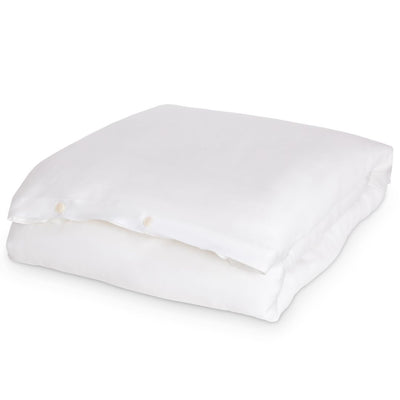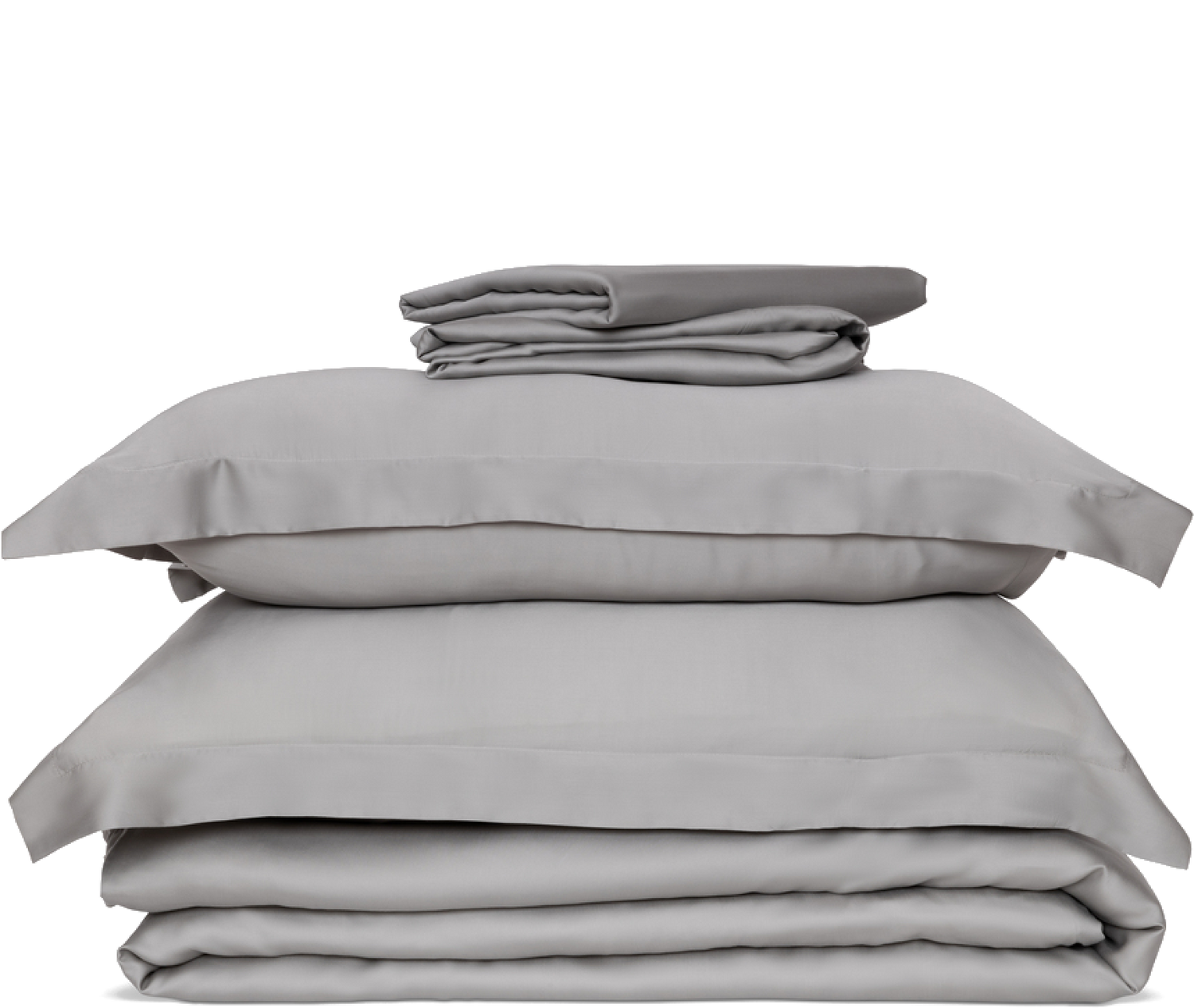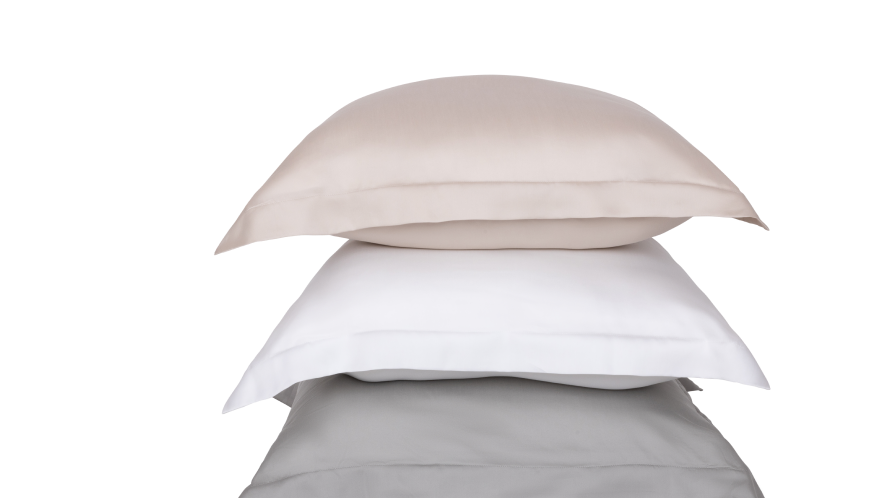A bedroom essential, your choice of duvet cover offers you the opportunity to add colour and personality to your space, while also protecting your duvet from spills, stains, and dirt. But from time to time, you’ll need to take your bedding off and put your cover through a wash to return it to its best.
In this article, we’ve outlined each step you need to follow when washing your duvet, including ways to combat persistent stains and the best methods for drying. We’ve also offered answers to the most common questions asked by our customers about washing your actual duvet, too.
What is a duvet cover?
You’ll likely be familiar with what a duvet is: a quilted shell that’s filled with a soft stuffing and designed to keep you comfortable and warm at night (if you’re interested in learning more, check out our guide to the best duvet fillings).
But what’s the function of a duvet cover, and why do you need one? Well, put simply, a duvet cover is a removable outer casing that protects your quilt from spills and stains, adds character to your bedding, provides luxurious softness, and enhances night-time cosiness.
Common materials used to provide high-quality duvet covers include Egyptian cotton, silk (or even better, ethically sourced eucalyptus silk), and synthetic polyester. Each material comes with its own benefits and drawbacks, so take the time to weigh up and consider your options before investing in your next bedding set.
Duvets vs comforters
If you’re thinking about buying new bedding, you might be debating between a duvet and comforter. However, there’s also a chance that you’re wondering what the difference is between the two! After all, they serve very similar functions. However, there are some key differences between duvets and comforters:
- A duvet requires a cover: your duvet will need a cover to protect the stuffed shell from everyday dirt and grime. Meanwhile, a comforter doesn’t require a cover, as it’s already designed to include a protective outer casing. This is the biggest and most noticeable difference between the two.
- You can change up your duvet style: the fact that a duvet requires a cover could be considered a drawback, as you need to buy more bedding, but this actually gives you the opportunity to choose the aesthetic that perfectly complements your character.
- Duvets are thicker: duvets are typically thicker than comforters, with different togs suitable for each season. In contrast, comforters are more like chunky blankets. As such, a duvet is often a more appropriate investment for year-round comfort.
Duvets and comforters each come with various advantages, but the main considerations you should make when investing in new bedding are cost are care. Both options are typically priced equally (depending on the material you choose), but you’ll also need to factor in the cost of an additional duvet cover. Meanwhile, a duvet is often easier to care for as you can simply throw the cover in the wash.
If you’re interested in learning more about these two types of bedding, explore our guide to choosing a duvet vs comforter.

Find Our Bamboo Duvet Fused With Eucalyptus - From £89
How to wash a duvet cover
Talking of washing your duvet cover, how exactly do you go about this? To make things simple, we’ve outlined each step to make sure you’re properly looking after your duvet cover.
1. Remove your duvet cover
The first step is to remove the duvet cover from your quilt, as you’ll need to wash it separately. In fact, you’ll only need to wash your duvet every six months or so, whereas you’ll need to wash your cover every week or two. To avoid damaging the fabric or snagging the fibres, take care when removing your duvet cover.
Put your duvet cover in the washing machine
Once you’ve removed your cover, it’s time to put your bedding in the washing machine. It’s important not to overload your machine, so don’t cram in your cover unless there’s room for it to move and spin freely during the cycle.
Top tip: If you’ve noticed particularly prominent stains, it’s often best to address these before putting your bedding in the washer. To do this, dab the stained area with a cleaning detergent until it begins to fade. Then rinse and put your bedding in the machine as usual. If you’re experiencing discolouring, read our guide to getting yellow stains out of white bedding.
3. Add tennis balls to the washer
The next step is to add a few tennis balls to your washing machine. These are a DIY substitute for laundry balls, so if you have the real thing, feel free to use these instead (and if you have neither, you can also use rolled up pairs of socks). Essentially, adding tennis balls to your laundry helps to keep your bedding moving throughout the cycle, which provides a more consistent wash.
4. Add your chosen laundry detergent
Once you’ve loaded your laundry, it’s time to add your chosen detergent. The amount you’ll need may vary depending on the type you choose (we’d recommend an eco-detergent), so it’s always handy to read the label instructions beforehand. However, it’s important to not just add more if you’re unsure; too much laundry detergent can actually leave streaky marks and discolour your duvet cover.
5. Set the cycle and wash your duvet cover
Next, you’ll need to set your washer to the correct cycle. This is your last chance to double check the care instructions on your labels, so make sure to give them a final check.
Once ready, we’d suggest washing your duvet cover on a gentle, cool cycle. Not only will this protect your bedding and ensure a thoroughly clean finish, but it’s also the more eco-friendly washing method and will save you money on your energy bill.
6. Remove your cover and check for residue
With the washing cycle complete, you’ll need to carefully remove your duvet cover from the machine and give your bedding a quick once-over for soap residue or streaking. If you’ve used the right amount of detergent and given plenty of room for your cover to turn in the machine, you should be fine, but it’s always worth checking.
If you do notice a little residue, the easiest solution is to put your bedding through a second cycle. It’s important to make sure your bedding is completely free of soap, as the subsequent bacteria build-up that could occur can lead to skin inflammation and allergic reactions.
7. Dry your duvet cover
Once washed, it’s time to dry your duvet cover. The best method of drying is actually on the line in the sun. This is because the sunlight acts as a final mode of sterilisation and kills any remaining bacteria that’s managed to survive the wash. However, if you’d rather tumble dry your bedding, we’d suggest a quick cycle on a medium-low heat.
Once finished, make sure your duvet cover is completely dry before folding and storing or re-making your bed, to prevent mould or bacteria growing on the surface. If you’re in any doubt about the dryness of your duvet cover, let it air for a little while longer.
8. Wash the rest of your bedding
Last but not least, it’s time to wash the rest of your bedding. This includes carefully washing your bedsheets and pillowcases, ensuring you’re not damaging the delicate fibres, and drying them appropriately. At this point, while the machine is running, you can make your bed with fresh sheets, pillowcases, and duvet cover, ready to slip into at the end of the day.
How often to wash a duvet cover
Generally speaking, you should typically aim to wash your standard cotton duvet cover on a weekly basis, or at the very least twice a month. However, specialist eucalyptus silk duvet covers can go much longer between washes. In fact, because of its hypoallergenic, moisture-wicking, and temperature regulating properties, you can often go 6-8 weeks before spinning your eucalyptus cover, reducing the amount of laundry you’re putting on and saving energy in the process.
When it does come to laundry day, the main reason to wash your duvet cover is, perhaps unsurprisingly, hygiene. If you leave your cover too long, dirt and grime will begin to accumulate, and your bedding will begin to harbour bacteria and mould, which can trigger allergic reactions at best and illness in serious cases.
Of course, there are a string of other reasons why you might want to throw your bedding in the wash more frequently, including excessive evening and night-time sweating, pet hair and dander triggering allergies, and food spillages. If you’re interested in learning more, explore our handy guide that explains how often you should change your bedding.
When to replace a duvet
Typically, your duvet will last at least five years, but a standard quilt should remain in good condition for the best part of a decade. Of course, this depends on the quality of your duvet (and your choice of duvet cover), with better materials and fabrics often lasting longer.
However, you’ll inevitably need to replace your duvet at some point, so it’s important to be aware of the main signs. The most noticeable indicator is your duvet filling beginning to leak, whether it’s feathers and down, wool, or a bamboo blend. When combined with uneven bumps and clumping, you can be pretty certain that your duvet’s time is up.
Frequently asked questions: how to wash a duvet
We’ve delved into the details of washing your duvet cover, but how about your actual quilt? Discover the answers to all the most common questions about washing your duvet.
Can I ruin my duvet by machine washing it?
Before washing your duvet, it’s important to read the label and take note of any care instructions. However, you should be able to machine wash your duvet without complications. To prolong the lifespan of your quilt, though, it’s often a useful idea to always protect it with a high-quality duvet cover.
Can I put a duvet in the dryer?
The good news is that you should be able to tumble dry your duvet, though it’s still important to double check the care instructions just in case. Alternatively, if possible, you could also air dry your duvet in the summer sunshine. Not only is this more economical, but it’s also more hygienic and eco-friendly.
How long does a duvet take to dry?
The time it takes for your duvet to dry depends on whether you’ve put it in the machine or hung it on the line outside. For instance, if you’ve tumble dried your duvet, you can reasonably expect it to be ready within the hour, but if you’re relying on sunshine, you may be waiting all day.
How do you fluff a duvet after washing it?
Plumping up and fluffing your duvet is an important final step after washing, to ensure it remains as cosy and comfortable as the day you bought it. Fortunately, it’s quite simple: all you’ll need to do is grab two adjacent corners and give your duvet a good shake! This should redistribute the filling evenly.
Hopefully, you now feel a little more confident about washing your duvet cover and bedding, which should make the next laundry load a breeze! In the meantime, for even more handy insight from our sleep experts, head on over to the Ethical Bedding blog.

















